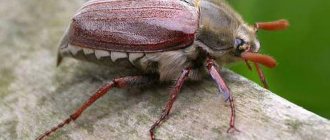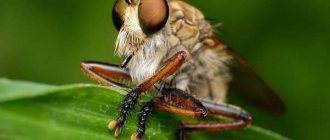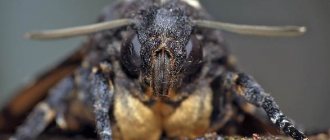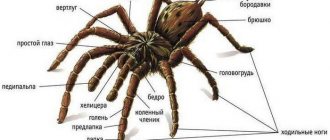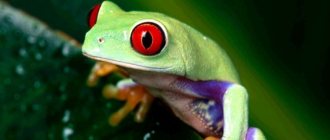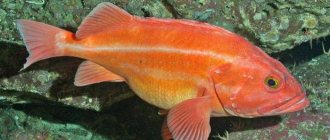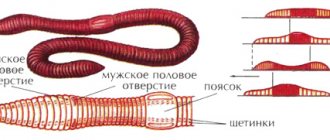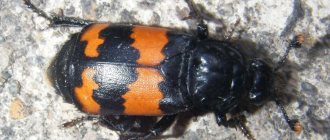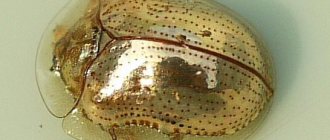During evolution, some insects changed the structure of the front pair of wings. The result was hard elytra filled with chitin. Because of this, the new order received the name “Coleoptera”, and popularly simply “beetles”. In terms of quantity and diversity, this is the largest group of living beings on the planet. Let's look at all the variety of species and in our review the most beautiful species of beetles living in nature.
Photos of the most beautiful species of beetles:
1
Ground beetles
Ground beetles (Carabidae) are mostly voracious predators. Strong legs and powerful jaws allow them to hunt successfully, destroying caterpillars, slugs and beetles. They live everywhere. The fauna of Russia and neighboring countries includes approximately 3,000 species.
A significant portion of ground beetles are black, but there are also colorful, bright exceptions
Habitat
Beetles are found all over the world, they live in forests, steppes, deserts, and tundra. Insects rarely live where there is permanent snow; they are not found in Antarctica. Beetles are found:
- in black soils;
- in the bark of trees;
- in deciduous cover.
Some species inhabit deserts. Such insects are adapted to different environmental conditions. They forage for food at night.
Most representatives of the Coleoptera order prefer to drink fresh and slightly salted water.
Water bugs
The aquatic, predominantly carnivorous beetles include diving beetles (Dytiscidae), whirligigs (Gyrinidae), and water-loving beetles (Hydrophilidae). The first two families are active predators not only at the adult stage, but also at the larval stage; water lovers are omnivores, but mainly feed on plant foods.
The large black water lover (lat. Hydrophilus piceus) reaches 48 mm in length
Mating season
Male representatives of the insect class fight with each other, occupying the most comfortable places. Males actively forage for food and often fight for females. Beetles are higher insects; their reproduction requires complete transformation. The egg passes into the larval stage, which becomes a pupa and subsequently develops into a full-fledged individual.
The female hides the eggs in fallen leaves or places them in stones. The larva can hatch in the bark of a tree, in curled leaves.
The eggs are usually white, green or yellow. On their surface there is a thin leathery shell. The size of the egg depends on the type of beetle in question. On average, it lives 15-20 days, after which it turns into a larva.
Larvae can be seen in the soil and tree bark. They are:
- yellow;
- white;
- pinkish.
The outer integument is brown or green and may have brown spots on the surface. The larvae differ not only in shape, but also in body structure; they are often elongated and dense. Some of them look like worms.
Some larvae have a chitinous layer, others do not. The head has hard coverings and a developed oral apparatus. When the larva develops, it molts. Life expectancy depends on the type of female and male, and the climatic features of the area play an important role. The larva can live from 2 months to 5 years. It should be noted that some arthropods reproduce in the larval stage.
Coleoptera representatives of the “Insect” class contribute to the pollination of garden crops. Beetles eat animal remains, resulting in faster decomposition processes. Predatory species are beneficial for the crop because they destroy their harmful counterparts. The importance of beetles in nature and human economic activity is difficult to overestimate. “Forest nurses” improve the ecosystem.
Dead eaters
The orderlies of our fields and forests are carrion eaters (Silphidae). A large number of these beetles accumulate near the corpses of dead animals, dig under the corpse, scooping out the soil from under it. Thus, they lower the corpse into the ground, where they then eat it together with their larvae. One of the few beetles that care for their offspring: adults feed the larvae, although they are capable of feeding on their own.
Gravedigger, or black-whiskered gravedigger (lat. Nicrophorus vespilloides)
Benefits and harms for humans
Some gardeners consider these insects to be harmful and take various measures to eliminate them from their plots. However, this opinion is fundamentally wrong, and drillers do no harm. Quite the contrary, these creatures bring great benefits to both the soil and the plants of the garden.
The main benefit is that the dung beetle is a decomposer ; it promotes the processing of complex organic compounds into simpler ones that can be absorbed by plants. That is, it is thanks to these insects that manure becomes “useful” and begins to “work” to increase productivity.
A striking example of the benefits of the beetle is the situation in Australia. The fact is that with the influx of settlers to the southern continent, the number of livestock here also increased sharply. Moreover, the breeding of the latter was facilitated by extensive pastures with green, lush grass.
However, the joy of the settlers (especially those who began to make money from the export of meat and wool) was short-lived. After just a few years, the vegetation ceased to renew itself, and many pastures turned into practically deserted areas. The change in diet from lush grass to sparse tough bushes had a negative impact on the number of livestock and on the quality of the products obtained from them.
After scientists (ecologists, biologists, entomologists and others) got involved in solving the problem, it became clear that the lack of vegetation is directly related to the excess of manure on former pastures. Having dried and compressed, animal waste simply did not allow the grass to “break through” to the light.
As a solution to the problem, these same scientists proposed using the “labor” of dung beetles. Since no suitable insects were found in Australia, they were brought here from other continents. Representatives of the lamellar shrews brought to the site quickly understood their task and in just a few years were able to correct the situation - the pastures of Australian cattle breeders were once again covered with fleshy green stems of herbaceous plants.
Considering all this, it is unlikely that any Australian gardener or gardener would call dung beetles harmful and dangerous insects. By the way, manure processing is not the only benefit brought by these Coleoptera. When equipping their shelters, they dig passages, loosening the soil, which, in turn, contributes to its saturation with oxygen.
In addition, by rolling dung balls, beetles contribute to the spread of various seeds (it is known that the droppings of large and small livestock contain undigested plant remains, including their seeds).
Lamellaridae
Lamellar beetles (Scarabaeidae), like many other beetles, are diversely represented in the tropics. 435 species of scarabaeids have been identified in the fauna of Russia. The largest tropical species is the African goliath, which was previously considered the largest among beetles. But later, a giant creaking creature larger than a goliath was discovered in the tropical forests of America.
Tropical bronze
Reproduction and lifespan
Like most insects, the development cycle of borers consists of 4 successive stages: eggs, larvae, pupae and adults. The mating season begins with the onset of summer. To procreate, insects mate for a short time.
After mating, the fertilized female lays 3-6 eggs measuring about 3 mm. For masonry, the same ball of dung beetle , carefully rolled by the parents in advance. Moreover, each egg is assigned its own dung ball and a separate “room” - a branch in the underground burrow.
After 28-30 days, the larva hatches from the egg. It has a thick, fleshy cylindrical body. The base color can be creamy white, beige or yellow. The head is brown. Like the adult insect, nature provided the larva with well-developed jaws of the gnawing type. She also has thick, short thoracic legs (the abdominal limbs are not developed). On her head there are antennae consisting of three segments. But she doesn't have eyes.
This stage of development can last up to 9 months, during which the larva of the dung beetle feeds on the manure prepared for it. After this time, the larva, which has gained strength and accumulated nutrients, pupates.
Interesting! All the time that the larva spends in its “room”, its waste products are not removed outside, but are collected in a special bag. Over time, as it fills, it forms a kind of hump on the back of the larva. The meaning of this device is to prevent the offspring of the dung beetle from being poisoned by its own waste.
The dung beetle spends about 2 weeks in the pupal stage, after which the shell bursts and an adult insect is born. The total development period of the dung beetle is 1 year, while adults live no more than 2-3 months - time sufficient to leave offspring.
Stag beetle
The stag beetle, a member of the stag beetle family (Lucanidae), is the giant of our forests; its length together with horns is 6-8 cm. This species is common in deciduous and mixed forests. Almost everywhere, the population of this species is low and continues to decline, so it is listed in the Red Books of both Russia and the countries where it lives. Male stag beetles have strong mandibles, similar to deer antlers, with which they fight. The larvae of these six-legged deer live in rotten stumps and hollows for five years before becoming beetles.
Duel between male stag beetles
Detailed description
Depending on the species, the beetle may have additional eyes. Insects that live in caves, as a rule, lack vision organs. A representative of Coleoptera has a powerful mouthparts designed for grinding food. This organ includes the upper and lower jaws.
Hercules beetles have the most massive mandible. The thorax of a representative of the order Coleoptera consists of 3 segments. In the area of the middle back there are elytra. Beetles have much in common with other representatives of the insect class; they have the following external organs:
- basin;
- shin;
- paws.
There are small dense hairs on the surface of the legs. There are many types of beetles. The most common ones have a uniform brown or brownish-yellow color. Red insects are common.
Less common are species with brightly patterned patterns. Some representatives of the Coleoptera order glow in the dark, they look beautiful and always arouse interest. Females, as a rule, are larger than males and their bodies are more elongated.
Some beetles have very developed mandibles, similar to horns (in this case, males are larger than females). Beetles communicate with each other and protect members of their population. When the male finds a female, he makes a characteristic sound that scares away other types of insects.
The beetle produces vibrations when its front chest rubs against the middle one. Representatives of this class of insects differ in size, but their structure is the same. In nature there are small, medium, and giant beetles. The maximum size of an adult is 21 cm. This species is called the “titan lumberjack.”
Zlatki
Gold beetles (Buprestidae) are very beautiful. Golden, green, yellow, with multi-colored spots. All borers have a very durable shell. They feed on leaves or thin bark of plants, causing significant damage to plants. In sunny weather, beetles quickly run from one place to another along tree trunks heated by the sun; No wonder they are called “children of the sun.”
Chrysanthemum on a buttercup flower
Bronzovka
Another beautiful shiny bug. The bronze beetle also includes the well-known inhabitant of summer cottages - the cockchafer.
Some bronzes have the most common black color, without any hint of a beautiful metallic sheen. These beetles are much faster than their other flying counterparts. Shiny bronzes can be green, blue, copper and purple and gold.
Unfortunately, these beautiful beetles are pests - they eat young fruits of fruit crops, cabbage, carrots, and beet leaves, and also gnaw out the stamens and pistils of flowers, which makes their further pollination impossible.
Narynniki
Blister beetles (Meloidae) have bright, often spotted warning colors. The blood of these beetles contains cantharidin, a substance that causes deep ulcers on the skin.
Epicauta hirticornis
T-shirt scarred
Unique insect abilities
May beetles fly at a speed of three meters per second - quite good for a small creature. In good weather conditions, they cover up to twenty kilometers per day. The flight altitude of the insect ranges from six to one hundred meters. The flight goal of all varieties of the cockchafer is always green spaces. The eastern insect prefers the nearest forest or tall trees. And western cockchafers orient themselves during flight to the highest objects in the distance, as a rule, these are forests.
A feature of these unique insects is their ability to find the right path. Studying the habits of the beetle, biologists caught them and moved them to a completely different place, releasing them after a couple of days. No matter how incredible it may seem, the insects took the same course, as if they were programmed to fly in a certain direction.
It is still unknown how beetles navigate. On the one hand, they determine the direction by the sun, but on the other hand, they fly perfectly even in the evening, when there is no sun. Apparently, polarized light is enough for them to understand where to move. Biologists even suggest that cockchafers are able to remember their surroundings, focusing on the most noticeable objects.
ladybugs
We often encounter small predators - ladybugs (Coccinellidae). These are beneficial insects and are often used in biological control of plant pests.
Ladybugs eat aphids and scale insects
Seven-spotted ladybug
Fanous
Fan whisker beetles are known precisely for their gorgeous mustache, consisting of at least twenty segments and resembling thickly painted eyelashes.
They are so rare that they are one of the least studied representatives of their species today. Fanwhiskers live in Australia and can only grow up to 25 millimeters.
Whiskers serve males to pick up pheromones from females of their species, and to understand how ready the female is for mating. The number of male fanwhiskers significantly exceeds the number of females, so they often have to fight among themselves for a fertile individual.
Leaf beetles
Among the brightly colored and often poisonous leaf beetles (Chrysomelidae), the Colorado potato beetle, which was brought from North America 100 years ago, is widely known. In its homeland, the striped beetle feeds on wild plants of the nightshade family, and in new conditions it has become a serious pest of potatoes.
The leaf beetle (lat. Chrysolina fastuosa) can feed not only on the leaf beetle, but also on nettles, mint and many other plants
Fruited nut
This is a very small bug with a very long proboscis, which is also often called the nut weevil. The nut fruit can be found in the European part of Russia and the Caucasus. The beetle's body is completely covered in brownish-yellow hairs, making it look like a miniature version of a sparrow.
Fruit veins emerge at the end of spring, when the weather is warm enough. They feed on leaves, hazel fruits, hazelnuts and acorns. Weevil larvae eat the nut kernel and fill its cavity with excrement. They are considered pests and are actively destroyed by owners of summer cottages.
Weevils
Bristle nodule weevil
Rice weevil
Barn weevil
Birch sapwood
All types of beetles (photos are given in the article) - bark beetles - have an excellent appetite. Birch sapwood was no exception. His favorite delicacy is old birch trees. But during reproduction, the parasite will not ignore young trees. If such an insect settles in a tree, it will live no more than a few years and die.
The beetle gnaws holes in the wood, which provide ventilation for their home and become a site for fertilization of females. The length of the insect does not exceed 6.5 millimeters. There are spots on the wings. Beetles fly en masse at the beginning of summer. They are now found throughout Europe. What kind of wood do beetles prefer? Different types of birch trees of all ages become home to parasites. In addition to gnawing tunnels, beetles also infect trees with fungi. Since their body is covered with villi, they easily spread spores. Diseased trees gradually lose branches and then die.
Bark beetles
Previously, bark beetles were considered a separate subfamily, but now they are classified as weevils. Small beetles, pests of tree species. Adult beetles can make “ticking” sounds by tapping their heads against the walls of tunnels they have gnawed into wood - they can often be heard in old wooden houses at night. A number of species have a device for removing debris that interferes with movement along the passages - a depression in the elytra, which is called... a wheelbarrow! Yes, yes, friends, these are the only bugs with cars.
Great spruce beetle (lat. Dendroctonus micans)
Interesting Facts
The dung beetle is not only an extremely useful, but also a very interesting insect. Here are just a few unusual and surprising facts about him:
- Having formed its ball, the beetle rolls it in the desired direction, guided by the stars!
- Long before the creation of special services, dung beetles helped predict the weather for the next day. Attentive people have noticed that if insects are more active during daylight hours, then the next day will definitely be warm, sunny and windless.
- According to scientists, up to 16 thousand dung beetles can live in one pile of elephant dung weighing only 1.5 kilograms.
- The beetle can sense potential danger. At the same time, it begins to produce a sound similar to a squeak.
- Dung beetles are able to extract moisture practically from the air (by the way, this is how many of them survive in the African desert). To do this, they turn towards the wind and spread their wings. After some time, particles of moisture begin to settle on the convex areas of the insect’s head. Gradually accumulating, the particles collect into a drop, which in turn flows directly into the dung beetle’s mouth.
- Drillers hold the record for strength among insects. After all, they are able not only to roll a ball that is much larger than themselves, but also to pull a load that weighs 90 times their own weight. In terms of human strength, dung beetles simultaneously move a mass equivalent to 60-80 tons (this is the approximate weight of 6 double-decker buses at once).
And dung beetles are also quite smart and inventive. Proof of this can be the experiment of the famous entomologist Jean-Henri Fabre with scarabs. While observing the beetle, the scientist “nailed” the dung ball to the ground using a pancake needle. After being unable to move the burden from its place, the insect dug under it.
Having discovered the reason why the ball could not be moved, the dung beetle tried to remove it from the needle. He used his own back as leverage. He needed just a little to carry out the idea. Subsequently, when Fabre placed a pebble next to a lump of dung, the beetle climbed onto it and nevertheless freed its “treasure”.
Nutcrackers
Click beetles have short legs, and if they fall on their backs, it is difficult for them to roll over. To regain support under their feet, they use an original device - something like a lever, protrusions on the chest (they can be seen in the photo below), with which they cling to the abdomen, and, straightening out, jump into the air with a click. The larvae are called wireworms, and many of them cause damage in vegetable gardens by gnawing tunnels in root crops such as potatoes. Some species, such as the blood-red click beetle (so named because of the color of the wing covers), develop in rotten wood and do no harm.
Ocellated click beetle (lat. Alaus oculatus)
Carnivores or carnivores
Predators (Adephaga) are prominent representatives of their subspecies. You can especially often hear about the name ground beetles, as the fastest insects on earth, of which there are more than 20 thousand species. The size of this subfamily can vary from 2 mm to 8 cm, and its habitats range from forests and fields in the middle zone to highlands. Not all ground beetles (photo) eat worms or insects, some of them eat plants and pose a serious threat to agriculture.
These now include famous horses, which were previously classified as a separate family. The largest of them in the Eastern Hemisphere live in Transcaucasia and Central Asia. But fewer people still know about the megacephalic beetle, measuring just over 2 cm, than about the name manticore, which lives in Africa and reaches 7-8 cm.
These are predators that are active at night and are not dangerous to humans. In addition, this is an endemic, distributed over a relatively small area, but a photo of this monster or the sight of a beetle on the wall of a room made an unforgettable impression on Europeans, who gave it the name of a medieval mythical monster.
Ground beetles are very beautiful beetles, the field beetle is bronze in color, the forest beetle is not just bronze-violet, but also decorated with golden dots, the Crimean and Caucasian beetles are blue and purple. There is only one name for picturesque paussinas, sometimes reminiscent of Egyptian hieroglyphs, on the territory of Russia.
But the steppe beetle, which is not particularly picturesque (the photo shows that it is black, slightly ennobled by golden dimples on its hard elytra), is very useful for humans because it eats cutworms, which are capable of destroying agricultural crops.
Predatory beetles (see photo) include whirligigs, phalaropes, water beetles and rhizodids. There are 22 of the latter, but only 2 are found in the post-Soviet space. Paussinae and horses were previously considered separate families.
Archostemata
In modern reality, ancient beetles (also called archostemata) remain in only 60 variants, and they are still divided into subfamilies and families. This is easy to explain if you know that the vast majority of them died out quite a long time ago, and those that survived still have primitive features in the structure of the abdomen and wings (see photo).
Only one lives on the territory of Russia, and his photo is quite rare in the specialized literature. He lives in the Primorsky Territory; two families exist only in North America.
These are interesting relics; by studying the photos and names of archostematous beetles, you can get a rough idea of the course of evolution in ancient times.
Mixophaga
Myxophages, like archostemata, are a small family that lives mainly near or in water and has 65 species. They were previously an important link in the food chain. Their photos are not particularly picturesque, and in the atlas of beetles of Russia they are practically a white spot.
Scientists are interested in the problem of why carnivores and predators survived in most species, while small ones stopped developing and went extinct.
